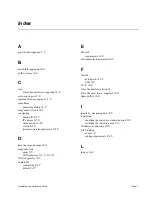
Glossary-6
Installation and Reference Guide
JBOD
Just a Bunch Of Disks; indicates a number of disks connected in a single chassis
to one or more controllers. See also RAID.
K28.5
A special 10-bit character used to indicate the beginning of a transmission word
that performs Fibre Channel control and signaling functions. The first seven bits
of the character are the comma pattern. See also Comma.
L_Port
Loop Port; a node port (NL_Port) or fabric port (FL_Port) that has arbitrated loop
capabilities. An L_Port can be in one of two modes:
•
Fabric mode Connected to a port that is not loop capable, and using fabric
protocol.
•
Loop mode In an arbitrated loop and using loop protocol. An L_Port in loop
mode can also be in participating mode or non-participating mode.
See also Non-participating Mode, Participating Mode.
Latency
The period of time required to transmit a frame, from the time it is sent until it
arrives.
Link
As applies to Fibre Channel, a physical connection between two ports, consisting
of both transmit and receive fibres. See also Circuit.
Link Services
A protocol for link-related actions.
LIP
Loop Initialization Primitive; the signal used to begin initialization in a loop.
Indicates either loop failure or resetting of a node.
LM_TOV
Loop Master Time-out Value; the minimum time that the loop master waits for a
loop initialization sequence to return.
Loop Failure
Loss of signal within a loop for any period of time, or loss of synchronization for
longer than the time-out value.
Loop
Initialization
The logical procedure used by an L_Port to discover its environment. Can be used
to assign AL_PA addresses, detect loop failure, or reset a node.
Loop_ID
A hex value representing one of the 127 possible AL_PA values in an arbitrated
loop.
Looplet
A set of devices connected in a loop to a port that is a member of another loop.
LPSM
Loop Port State Machine; the logical entity that performs arbitrated loop
protocols and defines the behavior of L_Ports when they require access to an
arbitrated loop.
LWL
Long Wavelength; a type of fiber optic cabling that is based on 1300mm lasers
and supports link speeds of 1.0625 Gbps. May also refer to the type of GBIC or
SFP. See also SWL.
Master Port
As relates to trunking, the port that determines the routing paths for all traffic
flowing through the trunking group. One of the ports in the first ISL in the
trunking group is designated as the master port for that group. See also ISL
Trunking.
MIB
Management Information Base; an SNMP structure to help with device
management, providing configuration and device information. The MIB types
provided with HP Brocade switches are described in the MIB Reference Manual.
Multicast
The transmission of data from a single source to multiple specified N_Ports (as
opposed to all the ports on the network). See also Broadcast, Unicast.









































